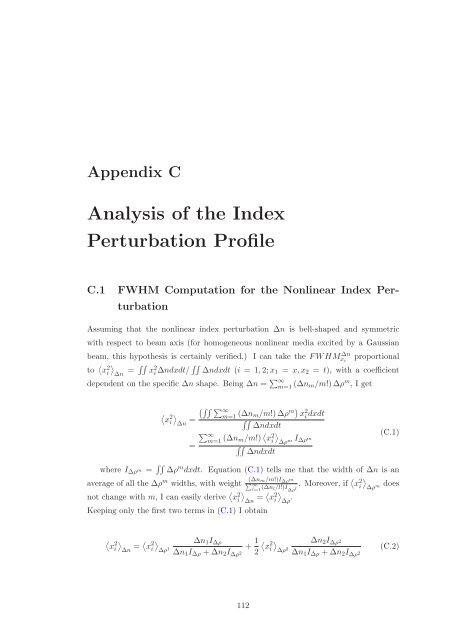Solitons in Nonlocal Media
Solitons in Nonlocal Media
Solitons in Nonlocal Media
Create successful ePaper yourself
Turn your PDF publications into a flip-book with our unique Google optimized e-Paper software.
Appendix C<br />
Analysis of the Index<br />
Perturbation Profile<br />
C.1 FWHM Computation for the Nonl<strong>in</strong>ear Index Per-<br />
turbation<br />
Assum<strong>in</strong>g that the nonl<strong>in</strong>ear <strong>in</strong>dex perturbation ∆n is bell-shaped and symmetric<br />
with respect to beam axis (for homogeneous nonl<strong>in</strong>ear media excited by a Gaussian<br />
beam, this hypothesis is certa<strong>in</strong>ly verified.) I can take the FWHM ∆n<br />
xi proportional<br />
to x2 <br />
i ∆n = x2 i ∆ndxdt/ ∆ndxdt (i = 1, 2; x1 = x, x2 = t), with a coefficient<br />
dependent on the specific ∆n shape. Be<strong>in</strong>g ∆n = ∞ m=1 (∆nm/m!) ∆ρm , I get<br />
2<br />
xi ∆n =<br />
∞ m=1 (∆nm/m!) ∆ρm x2 i dxdt<br />
<br />
∆ndxdt<br />
∞ m=1<br />
=<br />
(∆nm/m!) x2 <br />
i ∆ρm I∆ρm <br />
∆ndxdt<br />
(C.1)<br />
where I∆ρm = ∆ρmdxdt. Equation (C.1) tells me that the width of ∆n is an<br />
average of all the ∆ρm widths, with weight (∆nm/m!)I∆ρm ∞ l=1 (∆nl/l!)I∆ρl . Moreover, if x2 <br />
i ∆ρm does<br />
not change with m, I can easily derive x2 <br />
i ∆n = x2 <br />
i ∆ρ .<br />
Keep<strong>in</strong>g only the first two terms <strong>in</strong> (C.1) I obta<strong>in</strong><br />
2<br />
xi ∆n = x 2 i ∆ρ1 ∆n1I∆ρ<br />
∆n1I∆ρ + ∆n2I ∆ρ 2<br />
112<br />
+ 1 2<br />
xi 2 ∆ρ2 ∆n2I ∆ρ 2<br />
∆n1I∆ρ + ∆n2I ∆ρ 2<br />
(C.2)
















